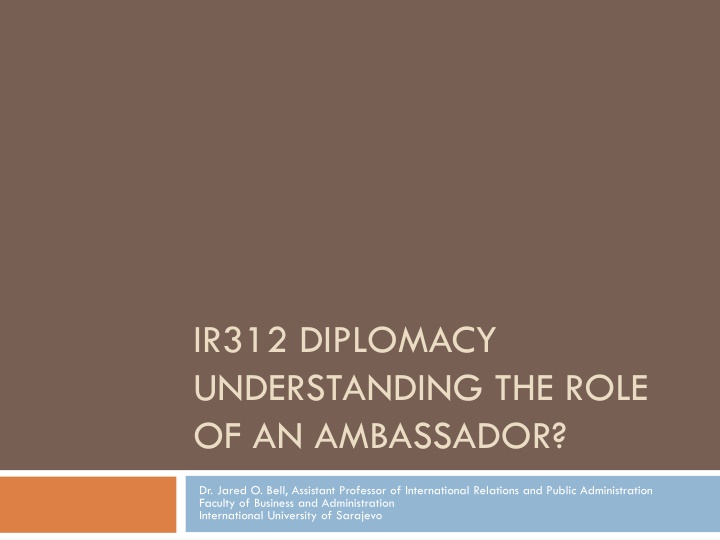Sustainability Analysis for Alternative Roofing Materials in Sri Lanka
This research explores the impact of asbestos use in roofing materials in Sri Lanka, focusing on health risks associated with asbestos and policy decisions. It also analyzes the distribution of roofing materials in occupied housing units and trends in asbestos and zinc-aluminum imports. The study aims to provide insights for reducing asbestos use and promoting sustainable roofing alternatives.
Download Presentation

Please find below an Image/Link to download the presentation.
The content on the website is provided AS IS for your information and personal use only. It may not be sold, licensed, or shared on other websites without obtaining consent from the author.If you encounter any issues during the download, it is possible that the publisher has removed the file from their server.
You are allowed to download the files provided on this website for personal or commercial use, subject to the condition that they are used lawfully. All files are the property of their respective owners.
The content on the website is provided AS IS for your information and personal use only. It may not be sold, licensed, or shared on other websites without obtaining consent from the author.
E N D
Presentation Transcript
IR312 DIPLOMACY UNDERSTANDING THE ROLE OF AN AMBASSADOR? Dr. Jared O. Bell, Assistant Professor of International Relations and Public Administration Faculty of Business and Administration International University of Sarajevo
Course Website https://professorbellreadings.wordpress.com/ir312 -diplomacy/
British Embassy Visit the British Embassy is scheduled on Wednes day, November 2nd. The transportation will be available in front of the University Canteen at 10:25am.
Diplomatic Mission Given all we have talked about concerning diplomacy, what do you think a diplomatic mission is?
A Diplomatic Mission is A diplomatic mission is a group of people from one state or an international inter-governmental organisation (such as the United Nations) present in another state to represent the sending state/organization officially in the receiving state. In practice, a diplomatic mission usually denotes the resident mission, namely the office of a country's diplomatic representatives in the capital city of another country.
A Diplomatic Mission is (Cont.) All missions to the United Nations are known simply as permanent missions, while EU Member States' missions to the European Union are known as permanent representations and the head of such a mission is typically both a permanent representative and an ambassador.
Think about your own experiences What are some of your experiences with Embassies, your own or foreign?
Understanding the Term Diplomatic Mission A permanent diplomatic mission is typically known as an Embassy, and the head of the mission is known as an Ambassador, or High Commissioner. The term "embassy" is commonly used also as a section of a building in which the work of the diplomatic mission is carried out, but, strictly speaking, it is the diplomatic delegation itself that is the embassy, while the office space and the diplomatic work done is called the Chancery.
Ranking in Bi-lateral Relations Ambassador (High Commissioner in Commonwealth missions to other Commonwealth countries); ambassador at large Minister Minister-Counsellor Counsellor First Secretary Second Secretary Third Secretary Attach Assistant Attach
Ranking in Multi-Lateral Diplomacy An ambassador-at-large is equivalent of an ambassador and assigned specific tasks or region in which he is assigned various assignments aimed at multi track diplomacy. A permanent representative is the equivalent of an ambassador, normally of that rank, but accredited to an international body (mainly by member and possibly observer states), not to a head of state. A resident representative (or sometimes simply representative) is also a member of the diplomatic corps, but is below the rank of ambassador. A representative is accredited by an international organization (generally a United Nations agency, to a country's government. The resident representative typically heads the country office of that international organization within that country. A special ambassador is a government's specialist diplomat in a particular field, not posted in residence, but often traveling around the globe. The U.S. Trade Representative (USTR) is an ambassador of Cabinet rank, in charge of U.S. delegations in multilateral trade negotiations (since 1962). The USTR's Special Agricultural Negotiator also typically holds an ambassadorial appointment.
Ranking in France Ambassadeur de France, an honorary dignity Ministre pl nipotentiaire, the most common rank for heads of mission, but it also applies to some ministers-counsellors in important embassies Conseiller des affaires trang res or Counsellors Secr taire des affaires trang res or Secretaries
Ranking in the United States Career Ambassador, awarded to career diplomats with extensive and distinguished service; Career Minister, the highest regular senior rank; Minister-Counselor; and Counselor.
Whats the role of an Ambassador? With everything we ve discussed in class, what do you think the role of an ambassador is?
An Ambassador is An ambassador is an official envoy, especially a highest ranking diplomat who represents a state and is usually accredited to another sovereign state, or to an international organization the ambassador is the personification of international relations between states. He is a visible symbol of foreign relationships even more than his or her direct boss, the foreign minister and the official apparatus that the minister heads called variously the ministry of foreign affairs, the foreign office, the external affairs ministry.
An Ambassador is (Cont.) the ambassador is the personification of international relations between states. He is a visible symbol of foreign relationships even more than his direct boss, the foreign minister and the official apparatus that the minister heads called variously the ministry of foreign affairs, the foreign office, the external affairs ministry.
Historical Concept of Ambassadors The rise of the modern diplomatic system was a product of the Italian Renaissance (from around 1300 AD). The use of ambassadors became a political strategy in Italy during the 17th century. The political changes in Italy altered the role of ambassadors in diplomatic affairs. Because many of the states in Italy were small in size, they were particularly vulnerable to larger states.
Ambassadors Today There are 188 ambassador posts, although some may be vacant at any given time.
Commonwealth Nations and Ambassdors Because members of the Commonwealth of Nations have or had a common head of state, they do not exchange ambassadors, but instead have High Commissioners, who represent the government, rather than the head of state.
Ambassador and Host Country Relationship The host country typically allows the ambassador control of specific territory called an embassy, whose territory, staff, and vehicles are generally afforded diplomatic immunity in the host country. Under the Vienna Convention on Diplomatic Relations, an ambassador has the highest diplomatic rank. Countries may choose to maintain diplomatic relations at a lower level by appointing a charg d'affaires in place of an ambassador
Use of Ambassadors The use of ambassadors today is widespread. States and non-state actors use diplomatic representatives to deal with any problems that occur within the international system. Ambassadors now normally live overseas or within the country in which it is assigned to for long periods of time so that they are acquainted with the culture and local people.
Non-Diplomatic Ambassadors In a less formal sense, the phrase is used for high-profile non-diplomatic representatives of various entities (rarely states), mainly cultural and charitable organizations, often as willing figureheads to attract media attention; for example, film and pop stars make appeals to the public at large foro UNESCO or UNHCR activities sometimes during press- swarmed visits in the foreign country
Some Key Responsbilities The ambassador working together with his home counterparts at the foreign ministry has become: the facilitator, the handler of detail, the remover of obstacles, the master of logistics, the specialist of follow-up, the resident trouble-shooter, and the one who sometimes handles the fallout if there are problems, to put back on track a derailed relationship.
Key Roles Represent Policy Protecting Citizens Management Supports Prosperity Works for Peace
Representation Ambassadors represent their country s interests and goals to the host country they are serving in. The ambassador represents the their country at state functions, such as dinners, conferences, and other ceremonial occasions.
Policy Ambassadors relay policy stances and decisions to the foreign governments they're associated with. In some cases, they may negotiate trade or security agreements, or help facilitate joint policy statements.
Protecting Citizens An ambassador's function is to oversee the safety of citizens in foreign countries. While the majority of work done to help citizens distressed citizens of their home country is performed by staff workers -- typically consular officers -- the ambassador is ultimately responsible.
Management Plenty of mundane duties fall to an ambassador's lot. While embassies in small or less strategically important countries have small staffs, some embassies have large staffs composed of foreign service officers, such as public diplomacy, political and economic officers, in addition to clerical staff
Supports prosperity Another result of the increase in foreign travel is the growth of trade between nations. For most countries, the national economy is now part of the global economy. This means increased opportunities to sell and trade with other nations. When two nations are conducting a trade, it is usually advantageous to both parties to have an ambassador and perhaps a small staff living in the other land, where they act as an intermediary between cooperative businesses
Work for peace One of the cornerstones of foreign diplomatic missions is to work for peace. This task can grow into a fight against international terrorism, the drug trade, international bribery, and human trafficking. Ambassadors help stop these acts, helping people across the globe.
How are Ambassadors appointed Ambassadors are picked and appointed depending on their country s specific rules and regulations for appointment. An Ambassadorial appointee s credentials have to be approved by the host country
Diplomatic accreditation Diplomatic accreditation is the process in which an ambassador is certified as one country's official representative to another. Accreditation occurs when a new ambassador presents "letters of credence", or diplomatic credentials, to the host country's head of state. Letters of credence, which are signed by the ambassador's own head of state, confirm that the ambassador is authorized to represent his or her country, and ask that the host country respect this fact. The presentation of letters of credence is often an elaborate ceremony, and serves as an official welcome to the new ambassador.
Diplomatic accreditation (Cont.) In accordance with the Vienna Convention on Diplomatic Relations, ambassadors are not regarded as having officially taken up their duties until the accreditation process is complete. Usually, an ambassador is accredited to only one country at a time, but this is not always the case multiple accreditations (often called dual accreditations or cross-accreditations) are possible. In this case, ambassadors live in one country, and travel to the others as required.
France The French ambassador in a foreign country (or the permanent representation to an international organisation) is appointed by the President of the Republic in a meeting of the Council of Ministers on the suggestion of the Minister of Foreign Affairs, that is to say following a very formal procedure.
France (Cont.) Once the future ambassador has been designated by the Council of Ministers, he has to obtain the approval of the country to which he will be going. It is only then that the appointment can be announced and published. Once he has arrived at his posting, he is received by the Minister of Foreign Affairs and subsequently by the Head of State, to whom he gives a letter from the President of the Republic which is notice of his appointment: this letter is known as the "credentials"
France (Cont.1) He is then accredited and enjoys the immunities and privileges guaranteed under international law which are designed to protect the ambassador from any pressure from the authorities of the host country.
The United States Ambassadors are nominated by the President and confirmed by the U.S. Senate. An ambassador can be appointed during a recess, but he or she can only serve as ambassador until the end of the next session of Congress unless subsequently confirmed. Ambassadors serve "at the pleasure of the President", meaning they can be dismissed at any time.
The United States (Cont.) An ambassador may be a career Foreign Service Officer or a political appointee. In most cases, career foreign service officers serve a tour of approximately three years per ambassadorship whereas political appointees customarily tender their resignations upon the inauguration of a new president. As embassies fall under the State Department'sjurisdiction, ambassadors answer directly to the Secretary of State.
Readings for Next Class Rana (2011).pp.130-147 Rana (2011).pp.229-246























